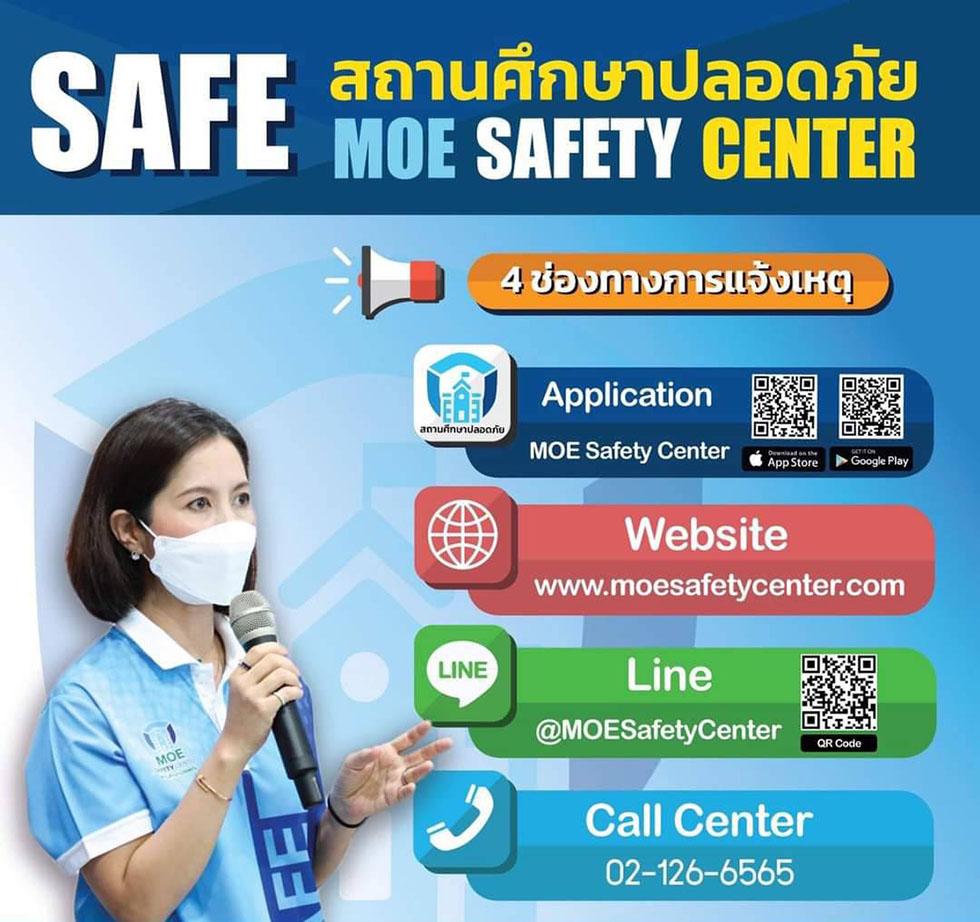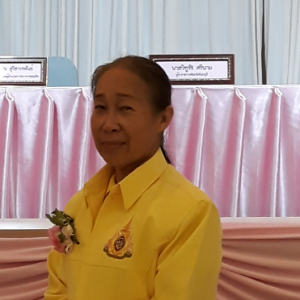การแก้ไขปัญหานักเรียนออกกลางคัน และเสี่ยงออกกลางคันในสถานศึกษา ของเครือข่ายการจัดการศึกษา สพป.จันทบุรี เขต 1 โดยใช้กระบวนการแบบมีส่วนร่วม
การแก้ไขปัญหานักเรียนออกกลางคัน
และเสี่ยงออกกลางคันในสถานศึกษาของเครือข่ายการจัดการศึกษาสำนักงานเขตพื้นที่การศึกษาประถมศึกษาจันทบุรี
เขต 1 โดยใช้กระบวนการแบบมีส่วนร่วม
(THE SOLUTION OF
PRIMARY SCHOOL STUDENTS’DROPOUT AND RISKY DROP OUT OF EDUCATION MANAGEMENT NETWORKOF CHANTHABURI PRIMARY
EDUCATIONAL SERVICE AREA OFFICE 1 BY
PARTICIPATION)
การวิจัยครั้งนี้มีวัตถุประสงค์เพื่อศึกษาข้อมูลบ่งชี้
และสร้างแนวทางการแก้ไขปัญหานักเรียนออกกลางคัน
และเสี่ยงออกกลางคันในสถานศึกษาของกลุ่มเครือข่ายการจัดการศึกษา
สำนักงานเขตพื้นที่การศึกษาประถมศึกษาจันทบุรี เขต1โดยใช้กระบวนการวิจัยเชิงคุณภาพและกระบวนการแบบมีส่วนร่วม
โดยมีผู้มีส่วนได้เสีย (stakeholder) คือ
กลุ่มผู้ให้ข้อมูลหลัก จำนวน 44 คน และกลุ่มเครือข่ายการจัดการศึกษา จำนวน 38 คน
ดำเนินการวิจัยระหว่างเดือนมิถุนายน 2561 ถึง เดือนสิงหาคม 2562
การวิเคราะห์เชิงปรากฎการณ์วิทยาโดยใช้การวิเคราะห์ข้อมูลเชิงคุณภาพ
และเครื่องมือการวิจัย ได้แก่ แบบสัมภาษณ์แบบกึ่งมีโครงสร้าง (แบบสัมภาษณ์เชิงลึก)
ผลการวิจัยพบว่า
1. ข้อมูลบ่งชี้นักเรียนออกกลางคัน และนักเรียนเสี่ยงออกกลางคัน
ประกอบด้วยข้อมูลบ่งชี้ 4 ประเด็น คือ 1) นักเรียนเบื่อเรียน 2)
นักเรียนเป็นเด็กพิเศษ/ มีความบกพร่องทางการเรียนรู้ 3) นักเรียนด้อยโอกาส และ4) นักเรียนถูกละเมิดสิทธิ์
2. แนวทางการแก้ไขปัญหานักเรียนออกกลางคัน
และนักเรียนเสี่ยงออกกลางคัน ดังนี้
2.1 นักเรียนเบื่อเรียน
ประกอบด้วย 9 กิจกรรม ได้แก่ 1)ค้นหาข้อมูลบ่งชี้ที่ทำให้นักเรียนเบื่อเรียน 2) ปฏิรูปสถานศึกษาทั้งระบบในด้านการบริหารทั่วไป การบริหารวิชาการ การบริหารบุคคล
และการบริหารงบประมาณ3) จัดภูมิทัศน์ แหล่งเรียนรู้
สร้างบรรยากาศ และสิ่งแวดล้อมที่เอื้อต่อการเรียนรู้4)
จัดโครงการ/ กิจกรรมที่เน้นผู้เรียนเป็นสำคัญ (Active Learning) 5) เสริมแรงทางบวกให้นักเรียนต้องการเรียนรู้อยู่เสมอ6)
จัดทัศนศึกษาตามความสนใจของนักเรียน 7) จัดกิจกรรมสำหรับนักเรียนที่มีความสนใจหรือมีความสามารถพิเศษด้านต่างๆ8)
จัดตั้งเครือข่ายเพื่อร่วมมือกันดูแล ช่วยเหลือ และแก้ไขปัญหานักเรียนอย่างมีประสิทธิภาพ 9) จัดรูปแบบพัฒนาทักษะชีวิต
พัฒนาทักษะวิชาการ และพัฒนาทักษะวิชาชีพ
2.2 นักเรียนเป็นเด็กพิเศษ/
มีความบกพร่องทางการเรียนรู้ ประกอบด้วย6กิจกรรม ได้แก่ 1) นำระบบดูแลช่วยเหลือนักเรียนมาใช้บริหารจัดการอย่างจริงจังและอย่างต่อเนื่อง2)จัดทำแผนการจัดการศึกษาเฉพาะบุคคล (Individualized
Education Program:IEP)ให้กับนักเรียน3) จัดหลักสูตร
กระบวนการเรียนรู้ กิจกรรม สื่อการเรียนการสอน
และสอนซ่อมเสริมให้เหมาะสมกับวัยและบริบทของนักเรียน 4) จัดหาครูการศึกษาพิเศษ
หรือส่งต่อนักเรียนไปยังสถานศึกษาที่จัดการศึกษาพิเศษหรือหน่วยงานต่างๆ
ที่เกี่ยวข้อง5) สร้างความเข้าใจและร่วมมือระหว่างสถานศึกษา
ครอบครัว และผู้มีส่วนเกี่ยวข้อง6)
สร้างรูปแบบพัฒนาทักษะชีวิต พัฒนาทักษะวิชาการ และพัฒนาทักษะวิชาชีพ
2.3 นักเรียนด้อยโอกาส
ประกอบด้วย 5 กิจกรรม ได้แก่1) สร้างเครือข่ายระหว่างสถานศึกษา ครอบครัวนักเรียน และหน่วยงานต่างๆ
ที่เกี่ยวข้อง2) จัดทำโครงการ/
กิจกรรมการเรียนการสอนที่ตอบสนองทักษะชีวิต ทักษะอาชีพ
และทักษะวิชาการให้กับนักเรียน3)
นำระบบดูแลช่วยเหลือนักเรียนมาบริหารจัดการอย่างมีประสิทธิภาพ และอย่างต่อเนื่อง4) จัดหาทุนสำหรับการศึกษา การดำรงชีวิต อาหารกลางวันฟรี จัดหาเครื่องอุปโภคและบริโภค
และจัดหางานทำให้กับนักเรียน 5) จัดทำโปรแกรมสำเร็จรูปเพื่อพัฒนาทักษะชีวิต
พัฒนาทักษะวิชาการ และพัฒนาทักษะวิชาชีพ
2.4 นักเรียนถูกละเมิดสิทธิ์
ประกอบด้วย4กิจกรรมได้แก่1)
ดำเนินงานตามระบบดูแลช่วยเหลือนักเรียนมาใช้บริหารจัดการอย่างเร่งด่วน
และอย่างมีประสิทธิภาพ2) จัดโครงการ/
กิจกรรมเพื่อสร้างความรู้ ความเข้าใจแก่ผู้ปกครอง นักเรียน
และผู้มีส่วนเกี่ยวข้องในเรื่องสิทธิเด็ก3)
ดำเนินงานให้ความช่วยเหลือ ติดต่อ ประสานงาน
และส่งต่อนักเรียนที่ถูกละเมิดสิทธิ์โดยเร็ว4)จัดทำโปรแกรมสำเร็จรูปเพื่อพัฒนาทักษะชีวิต
พัฒนาทักษะวิชาการ และพัฒนาทักษะวิชาชีพ
Abstract
The purposes of this study were:to study the
information indicating students’drop out and risking
drop out and create solutions in primary school students’dropoutand risking dropout of Education Management
Network of Chanthaburi Primary EducationalService area Office 1.The research method was Qualitative Method andParticipation bywhich the stakeholders were44key
informants who provided themaininformation and 38 people of the
EducationManagement Network Group.The research
instrumentswerepractical
in-depth interviewand survey.Thephenomenologicalanalysis used
to analyze the collected qualitativelydata.
The finding revealed that;
1. The information indicating students’drop
out and risking drop out; include of4 issues:1)Bored students of studying.2)Special children/learning
disabilities.3)Disadvantaged
students.4)Students are
violated potentialities.
2. The problems indication of students’drop
out and risking drop out consisted of:
2.1 Bored students have 9 activities which were:1)Finding a cause of problems that make students to be
bored of learning.2)Whole School
system Reform in general administration, academic administration,
personnel management and budget management.3)Creation the school landscape, learning resources, school
atmosphere and the environment to provide to students for studying.4)Organizeprojects/activities that focus students centered. (Active
Learning) 5)Reinforce
positiveenergy for students always want to learn.6)Organize group trips to learn for students.
7)Organize activities for students who are interested or have a
special talents in various fields.8)Establishnetwork of school to collaborate, look after,
helping and solving problems efficiently.9)Formatthe
development of life skills, improve academic skills, anddevelopprofessional
skills.
2.2 Students are special children/Learning
disabilities have 6 activities which were:1)Implementing a system to help support students to
manage seriously and continuously. 2)Making the plan of the Individualized Education Program:IEP foreachstudent.3)Making studying contents, learning process,activities
of learning, instructionmedia,
technologyand teaching remedies to suit the age and context of students. 4)Finding the special
learning or sending students to the special education school orother institution.5)Making the good understanding and good cooperation
between school,families and related persons to repair the problem
of students.6)Create a
model of develop life skills, improve academic skills, and develop professional
skills.
2.3 Disadvantaged students
have 5 activities which were:1)Create
network betweenschools, student of family and various departments
associated.2)Create
projects, learning activities that respond to life skills, professional skills
and academic skills for students.3)Implementing a system to help support students to
manageefficientlyand
continuously.4)Funding
for education, living, free lunch, supply consumer goods and recruitment for
students. 5)Prepare the program to develop life
skills, professional skills and academic skills.
2
.4 Students are violated potentialities have 4 activities which
were
:1
)Operateaccording
to the student support system for urgently management and efficiently
.2
)Organize
project activities to create knowledge and understanding for parents, studentsand
related persons about children
’s rights
.3
)Provide assistance, contact,
coordinate and forward the students who have been violated right quickly
.4
)Prepare the program to
develop life skills, professional skills and academic skills
.
 จังหวัดจันทบุรี
จังหวัดจันทบุรี 






